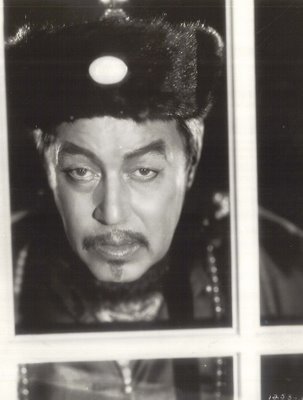

We Want Our Fu Manchus!
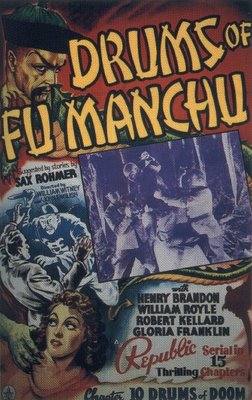
It's frustrating to write about films we can't all see. I’d read about the Paramount Fu Manchu series for years, but had never gotten to look at any of them, other than a bootlegged DVD of The Mysterious Dr. Fu Manchu I viewed just today. So what’s the holdup with these early sound thrillers? Why are all three unavailable beyond occasional archival showings? The problem apparently lies with the Sax Rohmer estate. He conceived the character and wrote the novels upon which the movies were based. It would seem that Paramount’s use of the properties was limited to the initial release of the three features they produced --- those being The Mysterious Dr. Fu Manchu (1929), Return Of Dr. Fu Manchu (1930), and Daughter Of The Dragon (1931). The literary rights reverted back to Rohmer and consigned the films to a sort of ownership Twilight Zone wherein all three exist, but none can be televised or distributed on DVD. The same cloud hovers over Republic’s 1940 serial, Drums Of Fu Manchu, a fan favorite that has only been available on gray-market discs of indifferent quality. UCLA Film Archives has excellent preservation materials on all these subjects, but must confine their exhibition to on-site festivals and infrequent loans to other institutions. Even though they hold the original nitrate negative for Drums Of Fu Manchu, UCLA has been unable to confirm the current rights holder, and any concerted effort to do so would be both time-consuming and expensive. The question ultimately becomes --- is any Republic serial worth this? Universal is the present owner of the three features; this goes back to MCA’s acquisition of them along with the rest of Paramount’s pre-1949 package in 1958. The Fu Manchus could not be released to television at that time, although Daughter Of The Dragon did go into the syndicated package by mistake, the absence of Fu’s name in the title allowing it to slip through. Consequently, there were nice 16mm prints of this one in circulation among collectors. The Mysterious Dr. Fu Manchu and Return Of Dr. Fu Manchu were, to my knowledge, not shown on television, and never available for rental, theatrical or otherwise. Preservation for the three features was made possible by donations from publisher Hugh Hefner in the late nineties, and they were shown at UCLA’s annual festival in 2000.



I’d like to report that progress is being made toward a general revival of the Fu Manchus, but Universal isn’t likely to expend that sort of time and expense for the benefit of such relics as these. Never mind the racial and ethnic sensitivities involved --- these are seriously dated shows. Folks that read Greenbriar Picture Shows might well stand on line to see them, but for civilians, they’d seem beyond ancient. Maybe I’ve dwelled in cinematic tombs too long, but I was actually surprised at what a vigorous film The Mysterious Dr. Fu Manchu turned out to be, even in my disadvantaged position of watching a lousy third-generation DVD. Candor forces me to admit that Warner Oland could read the daily classifieds and yet engage, an actor who need merely enter a room to dominate it. His Fu Manchu is much like the genial Charlie Chan with occasionally sinister overlays. The Mysterious Dr. Fu Manchu was released in August 1929, so we must make allowance for Paramount’s uncertainty with sound, but it’s a tremendous advance over talkies of only a few months earlier, and has a lot more energy than, say, The (glacial) Canary Murder Case. There’s a dynamic first reel that sets up Fu’s motivation for a lifetime of seeking revenge against the accursed white race, and plenty of cliffside mansion suspense later on. Maybe I was just in a good mood when I watched this, because I even enjoyed Neil Hamilton’s occasional tripping over lines. There’s an indefinable charm to these lurching, show-must-go-on early talkers --- actors and directors giving their all against what must have seemed overwhelming odds.


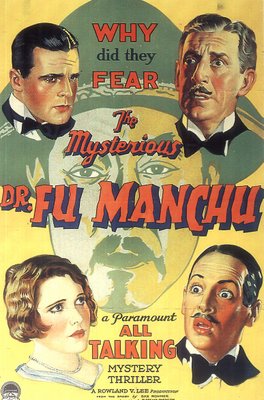
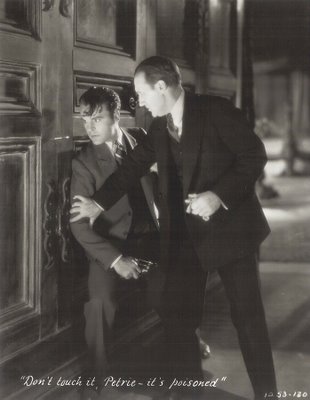
One of the great exhibition miracles was performed in August 1929 with the trailer for The Mysterious Dr. Fu Manchu. Ernest Morrison of Dallas’ Greater Palace Theatre followed his customary newsreel with a bath of green light throughout the auditorium as his screen widened to Magnascope proportion. This was mere lens adjustment to fill the entire proscenium and was used primarily for spectacular action scenes, such as the dogfights in Wings. Morrison filled the theatre with sounds of police sirens as the preview for The Mysterious Dr. Fu Manchu flashed on the screen. The Greater Palace’s live orchestra then went into an agitato theme until the first talking sequence of the trailer began. All the house lights were extinguished at this point, and red footlights began flashing on and off, with the further enhancement of two green spotlights operated from the booth --- roaming across the stage and all around the auditorium. The impact caused women to scream, and an otherwise unassuming trailer became the highlight of the program.
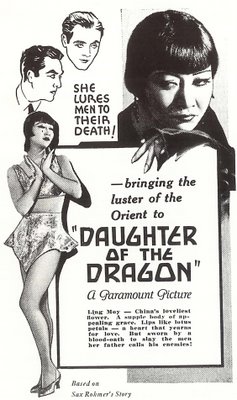
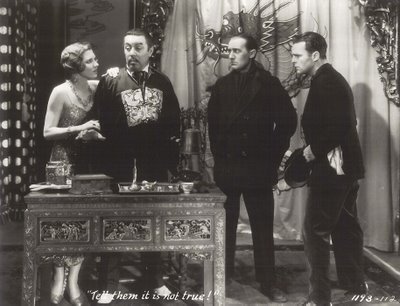
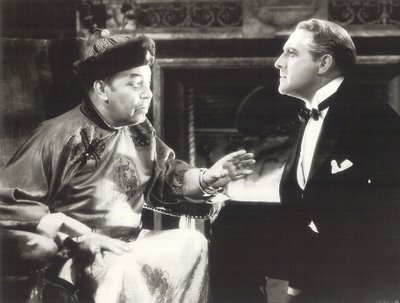
Sax Rohmer died in 1959. Most of his Fu Manchu stories were written in the twenties. Some of these are now in the public domain, but the character of Fu Manchu is still protected. If Universal, or anyone else, were inclined to pursue the rights for the three Paramount features or the Republic serial, they’d have to track down the legal representatives of Rohmer’s estate. From the best I could determine, his interests are represented by The Author’s League Of America (HERE). There’s also a British concern, The Society Of Authors, HERE, that specifically lists Rohmer’s estate on their website. I don’t know if anyone’s approached these entities about clearing the way for a DVD release, but it would be a wonderful thing if they could. These orphaned shows have been out of circulation far too long. Paramount’s features would make a nifty box set (they could even include Oland’s comedic skit as Fu Manchu in Paramount On Parade as an extra), and the Republic serial would make a lot of chapterplay enthusiasts very happy indeed. In the meantime, those of us not within driving distance of UCLA will have to make do with the enticing images shown here and whatever bootlegged videos can be scrounged up on e-bay.
5 Comments:
Another fascinating post. I'm within driving distance of UCLA, so I'll have to keep an eye out for any screenings down there. I remember seeing Daughter of the Dragon on late-late-night TV in the 1960s, and I remember it as rather slow (mainly, if memory serves, because of the lack of a musical score) but interesting, especially for Anna May Wong (a new face to me at that time) and Sessue Hayakawa (whom I of course remembered from The Bridge on the River Kwai). Warner Oland's role -- again, I'm relying on a memory of 40-plus years ago -- amounted to little more than a cameo. (And thanks for posting that gorgeous full-color magazine page of Anna May; what a sensuously beautiful woman she was!)
Apparently, later studios drove harder bargains with Sax Rohmer and his estate than did Paramount. MGM's The Mask of Fu Manchu with Boris Karloff, Lewis Stone and Myrna Loy (and Cedric Gibbon's wonderfully kitschy faux chinoise decor) was long a staple of local TV, and I have it as part of the "MGM Horror Classics" laserdisc box set; apparently no DVD yet. A couple of Christopher Lee's Fu Manchu films of the 1960s, and even episodes of the 1956 TV series with Glen Gordon, are available on DVD, though I can't speak to the quality of them. (And by the way, I see in Alex McNeil's Total Television that in 1952 Fox Movietone shot an unsold pilot for a Fu Manchu TV series starring John Carradine as Fu and Sir Cedric Hardwicke as Nayland Smith; how I wish some enterprising film preservationist would dig that one up!)
You've given me another stop on my itinerary when I finally get my ride in a time machine: I want to visit the Greater Palace Theatre in 1929 to see the trailer for The Mysterious Dr. Fu Manchu -- probably right after I zap to the London set of Conspirator to watch the shooting of that open-robe scene between Robert and Elizabeth Taylor.
Mask of Fu Manchu will be released on DVD next month as part of a set from Warner titled Hollywood Legends of Horror Collection, also to include Doctor X, The Return of Doctor X, Mad Love, The Devil Doll, and Mark of the Vampire.
I enjoyed this post very much and empathize with it totally. I believe the producer Harry Alan Towers claims to have the screen rights to the Fu Manchu character in perpetuity. He produced the five Christopher Lee films made in the 1960s, as well as some films based on Rohmer's female imperialist Sumuru. There was talk of Towers producing another a few years ago, but the plan evidently came to nothing.
Thanks to everyone for these informative comments. Good to hear from someone who saw "Daughter Of The Dragon" during the syndication days. Much appreciated, Jim. Really liked your piece on "Pop Gear" at Video Watchdog, Tim. Watched it last week on Flix, and it's fascinating. I well remember the newspaper ads when "Go-Go Mania" played area drive-ins, often on tandem bills with things like "Tomb Of Ligeia", "Planet Of The Vampires", or other AIP releases.
You know, another Warner Oland movie that languishes in the same state is the second Ronald Colman Bulldog Drummond movie, Bulldog Drummond Strikes Back. (It's usually referred to as a sequel to Colman's 1929 Bulldog Drummond, though it was made at a different studio by an entirely new crew apart from Colman.) Oland is the bad guy and he's a lot of fun in a very clever, somewhat self-parodying movie (you can read more about it in my IMDb review, look for the one by Mgmax). Unfortunately Fox no longer has the story rights, though bootlegs from foreign TV showings are out there and it played at Cinecon.
Post a Comment
<< Home